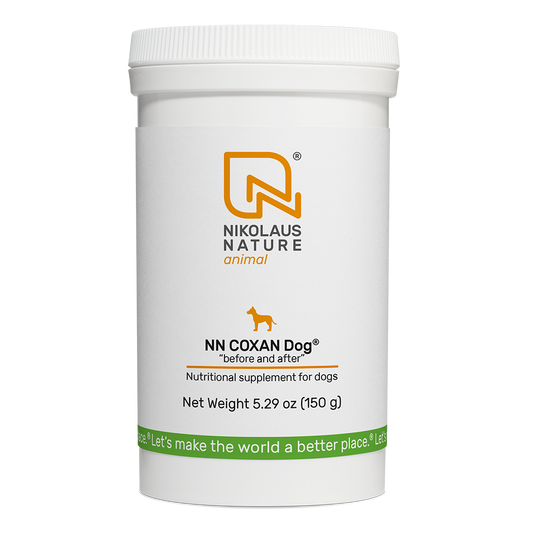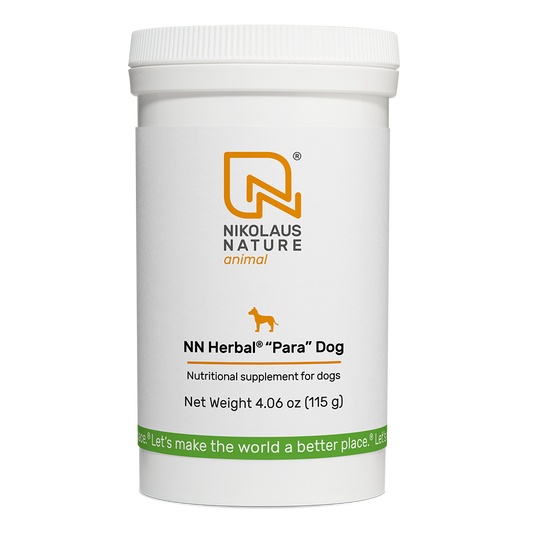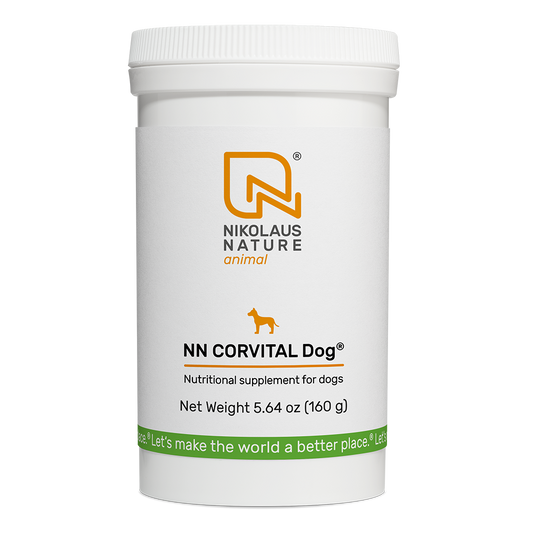Joy of movement and agility - throughout a dog's life
A healthy musculoskeletal system is the basis for a dog's quality of life and enjoyment of movement. This system, consisting of bones, joints, muscles, cartilage, tendons, and ligaments, ideally works together smoothly. Unfortunately, musculoskeletal disorders are not uncommon in veterinary practices. In this blog post, we will explore the causes of different joint diseases, how to prevent them, and which nutrients specifically support a dog's musculoskeletal complex.

Joint diseases can affect any dog
Every joint in a dog's body can potentially have problems or cause pain. However, there are certain diagnoses that are more common in veterinary practices and certain breeds that are more prone to specific joint diseases. Other joint impairments, such as osteoarthritis, can affect dogs of any age and breed. Genetics, diet, activity level, and age can all have an impact on the musculoskeletal system, both positively and negatively. The good news is that measures can be taken early on to minimize the risk of joint disease later in a dog's life.
Osteoarthritis: one of the most common joint diseases
Movement causes daily, unavoidable wear and tear on joints. Pressure and impact create tiny injuries to the joint cartilage. The body's own immune cells are responsible for repairing this damage - with the help of natural mini-inflammatory reactions. However, this repair function causes more damage than it helps in the case of strenuous sporting activities, very high continuous stress, or joint malpositions. This is because a permanent inflammatory reaction then develops in the joints. The consequences are joint wear, successive degradation of the articular cartilage, and severe impairment of the joints: the diagnosis is osteoarthritis.
Osteoarthritis is a chronic degenerative joint disease that can also occur due to age. This means that it is progressive and cannot be cured. As a further consequence, ligaments and tendons can also be affected by the disease. The symptoms of osteoarthritis - restricted movement, pain, and lameness - are often recognized very late when the disease is already far advanced due to its insidious onset.
Ostheoarthritis is not the same as arthritis
Although the symptoms of arthritis resemble those of osteoarthritis, the cause of the disease lies elsewhere. Here, the pain originates from inflammation instead of damage to the joint. This can be caused by viruses, bacteria, or autoimmune diseases. Osteoarthritis is primarily considered to be inflammation, which only subsequently leads to cartilage degradation, bone deposits, or thickened joint capsules. Dogs with osteoarthritis are also restricted in their movements, which promotes incorrect loading and can result in further inflammation. A vicious circle that should be broken out of as early as possible with a visit to the vet to contain the inflammatory process.
Dysplasia of the hip and elbow joint
The dreaded hip joint dysplasia (HD) and elbow joint dysplasia (ED) are caused by a maldevelopment of a joint usually at a very young age of the dog or during the growth phase. Often HD is genetically determined or some breeds are more susceptible to it than others. The consequence of this malformation is that the joint socket and the joint head do not fit together properly. This is manifested by incorrect stresses in the joint, which is not only painful for the dog but can develop into arthritis and arthrosis if left untreated.
Dysplasia can be very painful even in young dog owners and can lead to lameness. Owners of dysplasia-prone breeds and animals whose parents already suffer from dysplasia should take countermeasures as early as possible with appropriate methods.
Weak point: Knee joint
In addition to the very common dysplasia, osteoarthritis, and arthritis, smaller dogs, in particular, are increasingly struggling with patella or patellar luxation. During movement, the patella slips out of its designated groove in the knee joint. Patellar luxation is mainly manifested by dogs resting the affected leg or not putting any weight on it at all and limping.
How to recognize joint problems in dogs
Osteoarthritis is particularly insidious because the first symptoms are not noticeable until the dog is already in an advanced stage. However, there are signals and signs by which you can recognize incipient joint disease. These include a sudden change in gait, limping, or refusal to walk or make certain movements. Altered or limited mobility when standing up or lying down should also be taken seriously. Some dogs also show irritable or aggressive behavior and are reluctant or unable to be touched in the painful areas. Acute joint inflammation is usually accompanied by fever, fatigue, or tiredness - in such a case, rest is called for.
Help in case of emergency
If a disease has already been diagnosed by a veterinarian, the joint problem should be approached from several angles in order to achieve maximum quality of life for the dog. Therefore, after the initial orthodox medical treatment, a comprehensive therapy to restore mobility should be started as soon as possible. Manual therapies such as osteopathy, chiropractic, physical therapy, and massage can help relieve or prevent tension that can lead back to poor posture. With the help of acupuncture, pain can be relieved and well-being increased. Physical therapies such as underwater treadmills are aimed at building muscle and are particularly suitable for dogs that do not like to swim. Finally, diet and joint nutrients can be used to influence existing problems. All this can help to restore the joy of movement to a certain extent and avoid pain as much as possible.
Prevention is half the battle
As a dog owner, you can and should start thinking very early about how to support your dog's joints in the best possible way from puppyhood onwards. Especially owners of large breeds should already take measures in the young dog age, which promote healthy growth and avert possible late consequences. High-quality dog food is not only the basis to prevent musculoskeletal problems but also for a long and healthy dog life.
Furthermore, dogs that are active in dog sports should generally be provided with food supplements for the joints, as their nutrient requirements are increased due to the exercise. The joints of senior dogs - whether with or without problems - are particularly dependent on an additional supply of nutrients and appropriate joint care due to the age-related slowed metabolism.

Tips for supporting healthy dog joints on a daily basis:
-
Always take acute injuries seriously:
Every minor sprain or bruise triggers an inflammatory process in the joints. In most cases, medication is not necessary, and it is sufficient to support and promote the healing process with targeted nutrients. -
Weight management:
Excess weight means additional stress on cartilage and joints, increasing the risk of osteoarthritis. Avoiding excessive weight on the dog's ribs can help relieve the musculoskeletal system. Healthy, balanced food and regular exercise are effective ways to prevent overweight. -
Regular and well-dosed activity:
This applies to both healthy dogs and those with joint problems. Exercise ensures that joint cartilage is "lubricated" with synovial fluid to provide nutrients. The amount of exercise should be adapted to the breed, age, and physical conditions and limitations of the dog. Swimming is a great option that promotes healthy dog joints with minimal stress and strengthens muscles, stabilizing the joints. -
Avoid jumping:
Jumping, whether out of the car or onto the couch, puts tremendous stress on the joints and should be avoided as much as possible. The same applies to climbing stairs. If the dog is small, using the elevator or carrying them can be a better option. -
Warming pillows or warming compresses:
Warm pillows filled with cherry pits or grains can be easily applied to problem areas and provide numerous benefits. The warmth not only has a positive effect on the dog's overall condition but also promotes blood circulation, relieves tension, and alleviates pain. -
Note:
Do not use heat pads in cases of acute inflammation, as they can worsen the inflammation. -
Orthopedic dog beds:
High-quality dog beds with memory foam are designed to conform to the dog's anatomy while providing support and protection to the joints and spine. They are an excellent option for providing comfort and support to dogs experiencing discomfort.

The role of nutrients for joints and cartilage
Nutrition plays a crucial role in maintaining the health of the musculoskeletal system and can strengthen joints and cartilage in various ways. Ideally, targeted support is provided through the use of food supplements that contain the necessary vital substances, starting from puppyhood, to prevent any unpleasant surprises in the future. The risk of joint diseases naturally increases as dogs age. Natural vital substances help maintain healthy joints and mobility for as long as possible, stimulate joint metabolism, and promote the production of synovial fluid to prevent friction and pain.
Nutrients for muscles, skeleton, and cartilage
-
Chondroitin:
Chondroitin sulfate is a type of glycosaminoglycan found primarily in connective and cartilage tissue, as well as synovial fluid. As a nutrient, it can stimulate the production of joint fluid and help cartilage withstand stress better. -
Hydrolyzed Collagen:
Collagen is the primary building material for joints, tendons, ligaments, and bones. It promotes mobility and joint health. Hydrolyzed collagen provides the necessary amino acids for the body to rebuild collagen. It supports the production of healthy cartilage tissue, protects it from degradation, maintains its elasticity and strength, and aids in recovery after physical activity. -
Fish oils:
Fish oils are rich in essential fatty acids, vitamins, and antioxidants. They have anti-inflammatory properties, protect cells, and support the immune system. -
L-Carnitine:
L-Carnitine is a nutrient that helps burn fat and convert it into energy, supporting optimal body condition and, consequently, joint health. -
Methylsulfonylmethane (MSM):
MSM is a naturally occurring substance found in joints. It has anti-inflammatory properties that can inhibit inflammatory processes and provide pain relief.
If you are unsure about the level of activity your dog can handle or which dietary supplement is suitable for your dog, it is advisable to consult with your veterinarian or a physiotherapist.
Product recommendation
COXAN Dog “before and after”
- to strengthen and maintain a healthy musculoskeletal system for an extended period of time.
- to preserve the joy of movement from puppyhood to senior years.
- promotes flexibility and elasticity of cartilage and joints.
- for puppies, it supports the development of a strong and resilient musculoskeletal system.
- for senior dogs, it helps prevent joint wear and tear.






